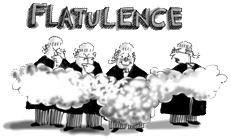Doctors v Lawyers
 Tulkinghorn •
Tulkinghorn •  Saturday, May 22, 2010
Saturday, May 22, 2010
 Legislators have the power to pass laws. Lawyers and judges have power to undo them by fancy interpretations and procedural shenanigans.
Legislators have the power to pass laws. Lawyers and judges have power to undo them by fancy interpretations and procedural shenanigans.
As the hugely experienced US politician John D. Dingle Jnr inelegantly said in 1983:
“I’ll let you write the substance … you let me write the procedure, and I’ll screw you every time.”
On the medical malpractice battlefield, doctors (if they get organised) control the legislatures. So, as the editor of Justinian opined in 2003:
“In a row between doctor and lawyer, you know who the politician will call.”
The medical indemnity crisis of the early 2000s resulted in big legislative wins for doctors reducing their liability for medical negligence, which the lawyers had previously been ratcheting-up.
But the lawyers control the judiciary, and that is why the common law (laws invented by judges) ensures that doctors are not immune from liability for their negligence when conducting medical operations in operating theatres, but barristers are immune from liability for negligence in court (which is their equivalent of an operating theatre).
In September 2000 Justice Kirby (as he then was) wrote:
“Suggestions that particular professional groups should enjoy legal immunity from suit for their errors adversely affecting other citizens would appear to fall on increasingly deaf ears.
At least this seems so as far as the courts are concerned. To the contrary, the trend of recent authority in the United Kingdom, Australia, the United States and elsewhere has been to extend liability and to reduce immunities, even where these were formerly provided by the law”.
Justice Kirby was writing when Giannarelli v Wraith was the last word on barristerial immunity in Australia.
In that case the High Court, by the narrowest of margins (4:3) had affirmed that barristers were immune from liability for their courtroom negligence.
Seasoned jurists like Justice Kirby (who was one of the three dissenters) could see the writing on the wall.
But despite the “trend of recent authority in the United Kingdom, Australia, the United States”, in 2005, in D’Orta Ekenaike v Victoria Legal Aid the Australian High Court not only upheld the immunity, but upheld it by a much bigger margin (6:1).
An analysis of the judgments can be read here.
Interestingly, the Victorian Bar had negotiated beforehand that if the barristers won the D’Orta case, then their members’ negligence insurance premiums would be lowered or partially refunded.
As far as I am aware, no Victorian barrister involved in the case saw fit to disclose an “interest” in the outcome.
While doctors are painted as motivated by a desire to reduce their negligence insurance premiums, a similar motivation for barristers was never mentioned in D’Orta.
In his article Do Judges Systematically Favor the Interests of the Legal Profession? Associate Professor Benjamin H. Barton of the University of Tennessee College of Law writes:
“Many legal outcomes can be explained, and future cases predicted, by asking a very simple question, is there a plausible legal result in this case that will significantly affect the interests of the legal profession (positively or negatively)? If so, the case will be decided in the way that offers the best result for the legal profession.”
The power of the High Court to favour the legal profession in medical negligence cases (by increasing doctor liability) is revealed by the recent case of Tabet v Gett even though the Court did not exercise that power in that case.
Arguably it refrained because if it introduced a new liability virus into medical practice, there was a very real risk that the virus would mutate into a species that would attack lawyers.
At issue was the “loss of a chance” principle.
The classic medical situation is where a person with cancer has, say, a 40 percent chance of being cured but the doctor negligently does not spot the cancer (and appropriate treatment does not begin) until the odds have reduced to 20 percent.
The patient has lost a 20 percent chance of a better outcome, but cannot prove, on the balance of probabilities, that he or she would have got better, had the doctor not been negligent.
The wonderful thing about “loss of a chance” (for Australian “med-mal” lawyers) is that it would make doctors liable for miniscule amounts of negligence that had no provable bad consequences for the patient.
This would be revolutionary stuff for negligence law in Australia, although most states in the USA have it.
In 2004 the NSW Court of Appeal had given its stamp of approval (in medical cases) to “loss of a chance” in Rufo v Hosking.
In 2009 in Gett v Tabet the NSW CA revisited the issue and said that the Rufo decision was “plainly wrong”.
But not, one hastens to add, “plainly negligent”. The law doesn’t work like that for judges.
Professor Barton’s article quotes a 1996 case which says that in the US a “majority of states have adopted the loss-of-chance theory” for medical malpractice.
He also says that while “the applicability of loss of chance to legal malpractice is obvious … the few courts to consider the issue … have consistently denied efforts to extend loss of chance to legal malpractice”.
In Gett v Tabet the NSW CA avoided discussing legal malpractice, but it did say that allowing recovery for the loss of a better outcome “would not readily be limited to medical negligence cases”.
In April this year a partner (Paul Koning) and an associate (Brent Basden) at US law firm behemoth K & L Gates put out a revised article entitled Legal Malpractice in Texas – The Basics.
They noted:
“In Kramer v. Lewisville Memorial Hospital, the Texas Supreme Court rejected the loss of chance doctrine in medical malpractice cases.
The Kramer court reasoned that if it adopted the loss of chance doctrine in medical malpractice cases it would then have to apply the doctrine to legal malpractice cases as well.
‘If, for example, a disgruntled or unsuccessful litigant loses a case that he or she had a less than 50 percent chance of winning, but is able to adduce expert testimony that his or her lawyer negligently reduced this chance by some degree, the litigant would be able to pursue a cause of action for malpractice under the loss of chance doctrine’.”
Professor Barton has investigated loss of a chance cases all over the USA. He says:
“The psychology of these cases is quite striking. While courts all over the country have adopted loss of chance for medical patients, the mere mention of applying it to lawyers is enough to convince some judges not to adopt the doctrine at all.”
 There was no need for our High Court to doubt its ability to restrict “loss of a chance” law to doctors and to hold it at bay as far as lawyers are concerned, if that was a concern.
There was no need for our High Court to doubt its ability to restrict “loss of a chance” law to doctors and to hold it at bay as far as lawyers are concerned, if that was a concern.
Any court that can keep barristerial immunity alive for as long as the High Court has, in the face of widespread opposition, need have no worries as to its ability to look after the interests of the legal profession.
Having trained the hugely profitable negligence law attack dog, the legal profession (brown dog) simply has to warn it away from lawyers on a case by case basis.









Reader Comments